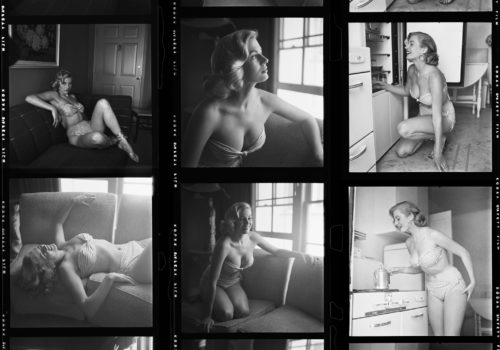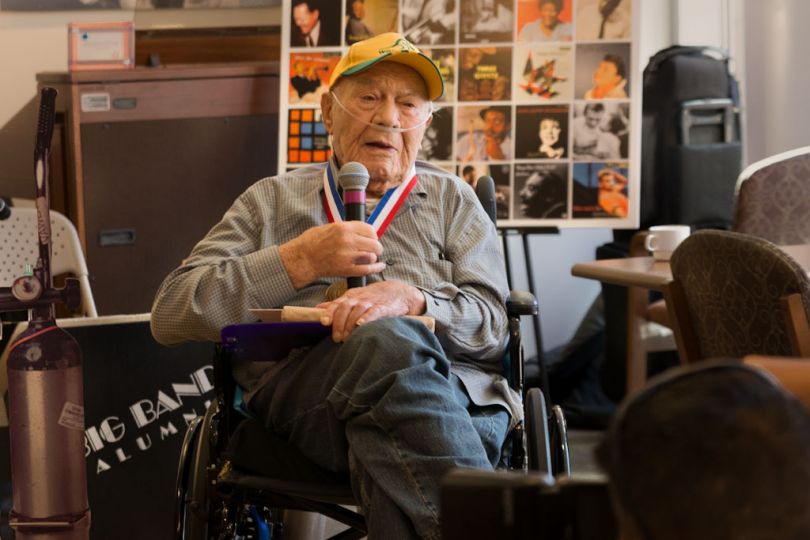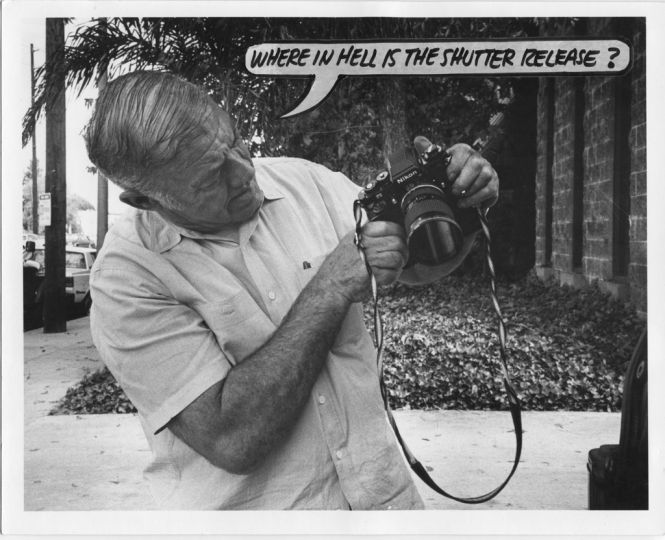“Phil Stern, Chronicler of Cool”
By David Friend
Sammy Davis, Jr. in his dressing room, lost in a cigarette’s reverie. Liza Minelli pushing half-sister Lorna Luft in a stroller. Frank Sinatra, in white tie, offering a light to JFK at the new president’s inaugural ball.
The photographs of Phil Stern, intimate chronicler of Hollywood and the jazz scene, convey an ease of access and an insider’s collusion that are virtually unknown in today’s Potemkin-village L.A. Back in the 40s, 50s, and 60s, before publicists ruled by fiat and photo op, certain superstars understood that when a charming guy with a camera came to call, the coolest thing to do was just to let him hang out. They recognized the value, and street-cred, that came from a behind-the-scenes photo essay in a glossy picture magazine. And so they often gravitated to straight-shooting Phil Stern, who worked for Life and Look and Colliers. (Indeed, the cover of his book, Phil Stern: A Life’s Work, from powerHouse, is designed with bold red-and-white graphics in order to approximate the cover of the old, weekly Life.) Studio moguls like Sam Goldwyn and Jack Warner let him into their inner sanctums. So did jazzmen like Art Tatum and Dizzy Gillespie. And supernovae such as Frank Sinatra, Marlon Brando, and John Wayne.
“Wayne and I were poster boys for the Odd Couple,” says Stern, now 91 and living in the same cluttered bungalow near the Paramount lot in which he has holed up for years. In the 60s, he and Wayne caroused through Europe, Africa, and Mexico. “Politically and socially, he was 140 degrees to the right of Genghis Khan. I was oppositely inclined. He’d call me a bomb-throwing Bolshevik. It was a love-hate thing. We’d get in big arguments, especially with a little booze in us.” Stern became such good friends with the actor that Wayne asked him to photograph his daughter Toni’s wedding, his yacht in Acapulco, and the Duke himself – at the wheel of his Boston whaler, in a pair of hot-pants-caliber short shorts. “That photo’s now popular in the gay aras,” says Stern, who agreed to license it for posters and postcards. “The picture was also published in the London Mirror and the headline was: Is It the Duke or the Duchess?”
Stern took a back-alley path to the Hollywood back lot (and, later, to the secluded dens of jazz’s giants). In his youth, he says, his Depression-era family lived “one step ahead of the shérif,” bouncing among the Bronx, Brooklyn, and Washington Heights. While a student at Manhattan’s Stuyvesant High, Stern swept floors in a Canal Street photo studio, worked the night shift at the unconscionably noir Police Gazette (taking pictures for $2.50 a pop), then shot for the left-wing journal Friday. During World War II, he enlisted in the Army photo corps and covered campaigns in North Africa and Italy, returning to his second home, Hollywood, not as another soft-focused dandy polishing the stars, but as a streetwise documentarian, more attuned to the world’s grit than its glamour. He developed what Robert Cushman, photography curator of the Academy of Motion Picture Arts and Sciences, calls an “in-your-face style” and an instinct for nabbing undoctored moments “thaï was honed by covering war.”
Over the course of his long career, Stern ended up stalking some 100 film sets (Citizen Kane, A Star is Born, West Side Story) on assignment for various studios and magazines. “I call him the Cartier-Bresson or Robert Frank of Hollywood,” says noted Los Angles photography dealer David Fahey, a Stern confidant. “He wouldn’t allow the orchestrated P.R. photograph. He made authentically real photographs, and in the context of Hollywood, to make a real picture is odd.”
Why did the giants of the cinema agree to let down their guard for this scrappy combat shooter? Stern believes that they may have sensed in him a common bravado. In 1943, facing down Rommell’s troops in Tunisia, Stern nearly lost his life in an artillery barrage; reinjured in the Allied invasion of Sicily four months later, he was soon shipped stateside. The War Department, in need of local heroes to hype, touted Staff Sergeant Stern and sent him on war-bond rallies with bandleader Artie Shaw. As a result, says Stern, he became a figure of valor in L.A. circles: “Bogart trusted me. [James] Dean trusted me. And Wayne. During the war, Wayne was never in the military. Bogart and Wayne may have seen themselves as a lot more macho than they actually were. I, in contrats, had been wounded. So my reputation in their eyes was as a tough guy.”
In a sense, Stern not only helped create a more laid-back brand of celebrity photo but also contributed to his era’s visual vocabulary of cool. In the process, Stern became widely known for his jazz portraits, photographing 40 album covers for Verve and becoming a fixture at studio sessions with the likes of Ella Fitzgerald and Louis Armstrong. Indeed, some of his best images of musicians and movie stars feel like breezy duets played through both ends of a lens. They impart what often seems to be his subjects’ hat-cocked complicity in the act of posing off-guard or suave or downright down-home for their nervy pal: Duke Ellington trimming his moustache; Bette Davis bar-b-queing wienies; Sinatra wolfing down a backstage lunch. Sinatra, in fact, instigated several Stern photo sessions. He enlisted his friend to take pictures at President Kennedy’s inaugural party in 1961 and, on occasion, persuaded Stern to create a faux photo or two. In one, Stern remembers, he shot “Sinatra literally in the position of Christ nailed to the cross. He choreographed it himself. This was a personal gag created for Mervyn Leroy, a director he had contempt for. He sent it along with a note that said, “O.K., you now have me where you want me. Frank.”
Come the 70s and 80s, Stern confides, “My career was sort of in eclipse. I was not getting assignments.” Then he received a call from Graydon Carter at Spy magazine, the irreverent journal of urban ego, launched in 1986. He credits Spy with rescuing him from sure obscurity. Stern soon realized he could mine his archive and, as he says, “recycle my youth. Spy was tickled pink with the stuff I do. They published the back view of stars Richard Attenborough, Jimmy Stewart, Hardy Kruger pretending to piss into the sand dunes on the Yuma, Arizona, set of Flight of the Phoenix. They ran that as a double-page spread.”
Stern’s star is again aglow. A new exhibition space in L.A.—The Phil Stern Gallery—will show his work and that of like-minded compatriots. A documentarian is making a film of his life story. His exclusive pictures of JFK’s inaugural ball 50 years ago appeared in last month’s edition of Vanity Fair and an electronic display of his most iconic shots is available for iPad-only viewing by downloading the Vanity Fair February Issue on the iPad. Each portrait gives notice that, to this photographer, access, and trust, meant everything.
“They’re happy pictures,” says former Life editor Daniel Okrent. “Phil was nice to have around so the stars he’s shooting seem relaxed. The secret to his work is that Phil’s a sweetheart. It’s as if he lit his pictures with his own personal sunshine.”
Stern’s sunshine was never brighter than at daybreak one March morning in 1955. One of Stern’s most famous shots — of James Dean astride a Triumph motorcycle — came about after a chance meeting on Sunset Boulevard, when Dean’s bike swerved in front of Stern’s Pontiac, then took a rough spill. “I cursed him out,” recalls Stern, describing how the biker got up from the pavement, dusted himself off, and introduced himself as James Dean. “We ended up having coffee and apple pie at Schwab’s.”
David Friend, Vanity Fair’s editor of creative development, served as Life director of photography during the 1990s. He is the author of Watching the World Change: The Stories Behind the Images of 9/11.
© David Friend
The Phil Stern Gallery is dedicated to keeping Phil Stern’s legacy alive with several shows per year that will consist of never before seen images and of course, his iconic images the world has come to know and love. The Gallery will use Mr Stern’s guidelines and curation for exhibitions of his work as long as he is willing and capable to do so. Being 91 he still wants to be as involved as he physically can.
The Gallery will have joint shows as time and space become available, with other photographers who will be selected within the guidelines of Stern’s wishes. The gallery will also work closely with the city of Los Angeles to show work from Los Angeles and “sister city” based photographers both established and up and coming. The gallery will work to preserve the arts in downtown Los Angeles to the best of its ability, by planning to have 1 show a year tied into a local charity geared towards the arts. The gallery also plans to have shows geared around charities of worldwide importance as we find images from our photographers archives with relevance.
The gallery will provide both vintage and fine art photographic prints of Phil Stern’s almost endless archive to collectors and the public. The gallery will provide the same from photographers as they join with the gallery to preserve the legacy of Phil Stern. The gallery will be dedicated to keeping fine art photography available for viewing and purchase in downtown Los Angeles in a wide variety of genres.
Geoff Katz
The Phil Stern archives are licensed exclusively by CPI NY
Phil Stern Gallery
601 S. Los Angeles Street
Los Angeles, CA 90014


















